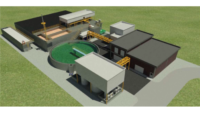Saving Steps
By Bryan Salvage, Editorial Director
Packaging used to transport meat and poultry from plants to the back rooms of stores or restaurants is becoming more convenient and end-user friendly.
Packaging that is used to transport product from a packing or processing plant to a central kitchen or the backroom of a supermarket or restaurant is normally not visible to consumers. Thus, the continuing evolution of this packaging segment oftentimes tends to fly under the radar. There has been, however, a great deal of interest and some significant changes in distribution packaging, says Huston Keith, principal of Keymark Associates, Marietta, GA.
“The workhorse of primal-meat packaging has been the vacuum shrink bag made chiefly by Cryovac,” he says. “The advent of case-ready was expected to [insure] the sunset of this package, but there have been some surprisingly new developments in both equipment and bags.”
For example, Curwood (which purchased Viskase) and Cryovac have both developed new films for bone-in primals, which to this day often do not use barrier bags, Keith relays.
“Viskase has also pioneered some lower-cost materials, which have now become the industry standard,” he adds. “Winpak has just announced its entry into the barrier bag fray with licensed technology from Asahi, the Japanese leader.”
The growing case-ready market has also caused a shift in bag sizing. Previously, the trend was toward smaller, “user-friendly” primals packed in smaller bags that are easier to carve into retail cuts, Keith says. But transporting meat to satellite plants has created more demand for larger bags, he adds. For higher-volume products, processors are able to use pallet-sized bulk boxes, which are lined with giant film liners.
“With concerns over listeria, E. coli, and other pathogens, there has been testing of high-pressure pasteurization,” Keith says, “which is already used for processed meats. For primals, this [process] will require enhanced strength for barrier bags. RapidPak has also introduced a new high-speed in-line vacuumizing machine. Alcan Packaging and perhaps others will market it in competition against Cryovac’s industry-standard rotary vacuumizing machine.”
Distribution packaging for the poultry industry hasn’t changed very much, Keith relays.
“The Master Bag seems to dominate, and there’s not much new on the horizon,” he adds.
Driving trends
Two trends are spurring change in distribution packaging, says Bill Kuecker, marketing director for foodservice, Cryovac.
“One is the big trend towards value-added foods going through the distribution channel in business-to-business [b-to-b],” Kuecker says. “This trend is all about taking steps out of the process for the end-user. It may be pre-seasoned, pre-cooked, or cooked at central facilities and then shipped out.
“As people become more sophisticated in understanding the system’s total value, and as they get better in quantifying net versus gross and as labor continues to be tight, all of these things are driving products towards more value-added goods coming through the system,” he adds. “Certainly, different packaging systems are needed for those products.”
The second trend is specific to foodservice.
“The No. 1 overriding buzzword in foodservice these days is fresh,” Kuecker says. “Cryovac did extensive consumer and foodservice industry research to better understand what that meant in relation to what form product was going through distribution – fresh versus frozen, for example.
“We found that both consumers and foodservice operators feel there is greater value in chilled fresh, and a large percentage of them were willing to pay more for chilled versus frozen product,” he adds. “Obviously, there are logistics issues involved that are certainly going to mitigate some of those consumer demands. But if we believe the consumer is right, this trend is going to dramatically affect packaging in the future.”
Cryovac offers a family of options for distribution packaging. Options include vacuum, modified atmosphere packaging (MAP), vertical form-fill packaging, and rollstock. “There has been interest on the MAP side, but we still see significant development and growth within the vacuum option, as well,” Kuecker points out.
“We’re developing very aggressively along these two trends: value-added foodstuffs, as well as for fresh chilled product distribution,” he adds. “One development is our cook-in TBG option. This allows a processor to cook bone-in products in a vacuum bag and then distribute product in that same bag,” he continues. “They can distribute all the way to the end-user. At that point, the end-user [the restaurant] would open that bag, put the ribs on a grill for several minutes, apply sauces, let the flames hit the ceiling for theater, and serve. This saves several steps along the course of the process.”
Ovenable bags have also been developed by the company. “This vacuum bag can go down our customer’s regular manufacturing line with no alterations needed for that line,” Kuecker explains. “Product can then go directly into a foodservice operator’s oven for cook.”
Eye on the deli
The supermarket deli is also very much a b-to-b business, and Kuecker expects products like his company’s ovenable bags to have retail, consumer, as well as industrial use.
“There are benefits for having a vacuum bag you can put in the oven,” he adds. “From the consumer standpoint, it certainly solves a lot of their issues as far as fear of failure while cooking. At the same time, it takes steps out for a foodservice or deli operator. It saves labor. It also results in a more consistent cook and yield.”
Looking to the future, Kuecker expects the step-saving packaging evolution to continue.
“If we use the simplest definition of value-added, which is any process that takes a step out of the process for the end-user, we expect that to continue because of the business constraints that are out there,” he says. “And packaging will have to reflect that.” NP


